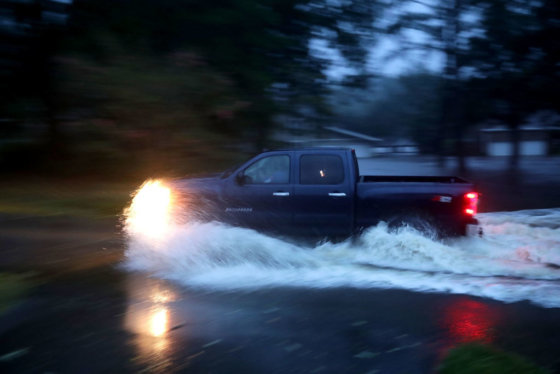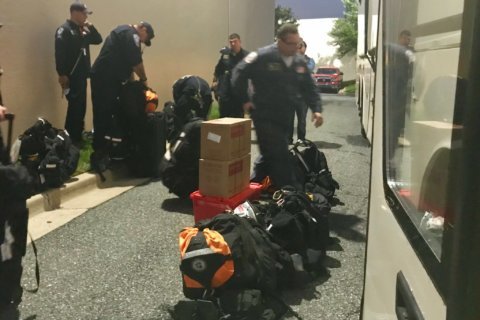A smartphone can be a lifeline in a hurricane, but preparation is key. You don’t want to be frantically downloading the Red Cross first aid app with 5 percent battery and spotty cell connections after the power is out.
Anyone in the path of Hurricane Florence should take steps to fuel their devices with maximum amount of power and necessary information. The category 4 storm’s rains and 130 mph winds may wipe out Wi-Fi, cellular service or power in areas along the North and South Carolina coasts.
From walkie-talkie app Zello to messaging app FireChat, which works offline, here’s how to get your mobile device ready ahead of the storm.
Prep your phone
Smartphones run through batteries fast. Without some restraint and backup plans, it could drain even faster during a storm when you’re constantly checking for updates.
Fully charge your main phone and any extra phones you have lying around in drawers. You could use them to call 911 or swap in your SIM card to do more. For backup power, charge any power packs you have, as well as laptops. In a pinch, you can charge a phone off of a laptop. Make sure you also have your cords ready, including one that can plug into a car — another power source.
Many newer smartphones have some level of waterproofing, but if you’re headed out into bad weather or someplace at risk of flooding, pop it in a Ziploc bag or two.
To stretch out the battery life, turn on low power mode, dim the brightness, and turn off any unnecessary notifications. You can see which apps use the most power in Settings. Close them and avoid reopening unless necessary.
Install apps
After Hurricane Harvey, locals and unofficial rescue crews used some lesser known tools to locate people in need. Consider installing Zello a walkie-talkie app that lets you share audio messages and photos. You can create new channels or join existing ones — there are several already about Hurricane Florence — to communicate with others in the area and ask for help. But the free app requires a Wi-Fi or network connection (even older networks like 2G will work).
Meanwhile, FireChat is another messaging app that works without data or a signal, and instead relies on mesh networks. (But Bluetooth and W-Fi need to be turned on even if access isn’t available, according to the company).
Glympse is a real-time location sharing app that complements Zello and FireChat. After using the apps’ messaging capabilities, Glympse users can share their exact whereabouts with rescue groups.
Airbnb’s Open Homes program helps those in need of shelter with people who want to list rooms or homes for free.
Finally, install a few of the Red Cross apps, which can offer first aid relief to both humans and pets.
Bookmark the basics
Go to your state emergency management or department of public safety site. Bookmark its main information page for the storm, and download any app they might have. While you are there, follow them on Twitter. Then do the same for your county and city or town.
Save your local emergency phone numbers to your phone, in case you can make phone calls but not search at a later time. Also bookmark pages for the National Hurricane Center, your local weather source, and FEMA.
Check online to see if your local 911 call centers can receive texts in an emergency. Texts can take longer to get a response, however. If you can’t get through to 911 on the phone, keep holding instead of hanging up and dialing again. If you do put out a call for help on social media, be sure to update it when you are safe.
You can also bookmark the webpages for Google’s Crisis Maps, which can show useful emergency information and shelter locations. Add CrowdSource Rescue, a site that tries to match people in need with neighbors who can help, and streamline emergency requests sent out over different social media platforms. Developed during Hurricane Harvey, the site was responsible for rescuing 25,000 in Houston, according to its creators.
Get push alerts
Go to your phone’s settings and make sure emergency alerts are enabled for extreme threats and severe threats. The government can push these alert, which may include an evacuation order, to phones in regions via the WEA (wireless emergency alerts) system.
Many local and state governments also use opt-in alert systems. Check their websites to be sure you have the best alerts setup. Text your zip code to 888777 to sign up for text message alerts from public safety departments using Everbridge. Another common system is CodeRED. You can sign up online here or download the app.
Stock up on maps
Maps can be a data hog. The Google Maps app lets you download entire maps for your area to your phone. On Android or iOS, search for your city and tap the more option (three dots), then tap “Download offline map.” Install the Waze navigation app if you think you’ll be driving and want to avoid unexpected road closures or accidents.
The-CNN-Wire™ & © 2018 Cable News Network, Inc., a Time Warner Company. All rights reserved.







